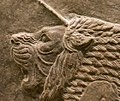மசார் சிங்கம்
மசார் சிங்கம் (Masarh lion) என்பது இந்தியாவின் பீகார் மாநிலத்தின் போஜ்பூர் மாவட்டத்தில் உள்ள அர்ரா நகருக்கு அருகில் உள்ள மசார் என்ற கிராமத்தில் காணப்படும் ஒரு கல் சிற்பம் ஆகும்.[1] இந்த சிற்பம் பொதுவாக கிமு 3 ஆம் நூற்றாண்டைச் சேர்ந்தது.
சிங்கம் அசோகரின் தூண்களைப் போலவே சுனார் மணற்கற்களால் செதுக்கப்பட்டுள்ளது. மேலும் மௌரிய சிற்பத்துடன் தொடர்புடைய ஒரு அம்சமான பளபளப்பான பூச்சுடன் உள்ளது. மேலும் அகாமனிசிய சிற்ப பாணியில் செதுக்கப்பட்டுள்ளது.
இந்த சிற்பங்களின் அம்சங்களை இந்தியாவைச் சேர்ந்தவை அல்ல என்று தொல்லியல் ஆய்வாளர் சுவராஜ் பிரகாஷ் குப்தா விவரிக்கிறார். இதே போன்ற எடுத்துக்காட்டுகள் கிரேக்கம் மற்றும் பெர்செபோலிஸிலும் அறியப்படுகின்றன. இந்தச் சிற்பம் இந்தியாவில் இருந்த அகாமனிசிய அல்லது கிரேக்கச் சிற்பியால் செய்யப்பட்டிருக்கலாம். கி.மு. 5ஆம் நூற்றாண்டுக்கும் கிமு 1ஆம் நூற்றாண்டுக்கும் இடைப்பட்ட காலக்கட்டத்தில் எங்காவது கிரேக்க அல்லது அகாமனிசிய மாதிரியைப் பின்பற்றியதாகவும் இருக்கலாம். இருப்பினும் இதன் காலம் மௌரியப் பேரரசின் காலத்திலிருந்து, கி.மு. 3ஆம் நூற்றாண்டு வரை இருக்கலாம்.
-
அகாமனிசிய பாணி சிங்கம்.
-
அகாமனிசிய பாணி சிங்கம்.
-
அகாமனிசிய பாணி சிங்கம்.
-
நினிவேவில் காணபடும் சிங்கம்.
-
கிரேக்க சிங்கம்,அப்பல்லோ கோயில், தெல்பி.
-
சாரநாத்தில் கிமு 3 ஆம் நூற்றாண்டைச் சேர்ந்த அசோக சிங்கத் தூபி
-
சாரநாத் சிங்கங்களில் ஒன்று
மேற்கோள்கள்
[தொகு]- ↑ Page 88: "It is carved out of Chunar sandstone and it also bears the typical Mauryan polish. But it is undoubtedly based on the Achaemenian idiom. The tubular or wick-like whiskers and highly decorated neck with long locks of the mane with one series arranged like sea waves is somewhat non-Indian in approach . But, to be exact, we have an example of a lion from a sculptural frieze from Persepolis of 5th century BCE in which it is overpowering a bull which may be compared with the Masarh lion."... Page 122: "This particular example of a foreign model gets added support from the male heads of foreigners from Patna city and Sarnath since they also prove beyond doubt that a section of the elite in the Gangetic Basin was of foreign origin. However, as noted earlier, this is an example of the late Mauryan period since this is not the type adopted in any Ashoka pillar. We are, therefore, visualizing a historical situation in India in which the West Asian influence on Indian art was felt more in the late Mauryan than in the early Mauryan period. The term West Asia in this context stands for Iran and Afghanistan, where the Sakas and Pahlavas had their basecamps for eastward movement. The prelude to future inroads of the Indo-Bactrians in India had after all started in the second century B.C."... in Gupta, Swarajya Prakash (1980). The Roots of Indian Art: A Detailed Study of the Formative Period of Indian Art and Architecture, Third and Second Centuries B.C., Mauryan and Late Mauryan (in ஆங்கிலம்). B.R. Publishing Corporation. pp. 88, 122. ISBN 978-0-391-02172-3.. Also Kumar, Vinay (Banaras Hindu University, Varanasi Faculty Member) (2015). "West Asian Influence on Lion Motifs in Mauryan Art" (in en). Heritage and Us (4): 14. https://www.academia.edu/10709971.







